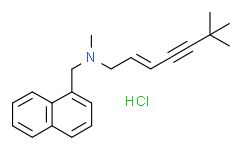| Cas No.: | 78628-80-5 |
| Chemical Name: | Terbinafine hydrochloride |
| Synonyms: | TERBINAFINE HYDROCHLORIDE;(e)-n-(6,6-dimethyl-2-hepten-4-ynyl)-n-methyl-1-naphthalenemethanamine monohydrochloride;(E)-N-(6,6-DIMETHYL-2-HEPTEN-4-YNYL)-N-METHYL-1-NAPHTHYLMETHYLAMINE HYDROCHLORIDE;LAMISIL;N-[(2E)-6,6-DIMETHYL-2-HEPTEN-4-YNYL]-N-METHYL-1-NAPHTHALENEMETHANAMINE;n,6,6-trimethyl-n-(naphthalen-1-ylmethyl)hept-2-en-4-yn-1-amine hydrochloride;TERBINAFINE HCL;TRANS-N-(6,6-DIMETHYL-2-HEPTEN-4-YNYL)-N-METHYL-1-NAPHTHYLMETHYLAMINE HYDROCHLORIDE;(e)-n-(6,6-dimethyl-2-hepten-4-ynyl)-n-methyl-1-naphthalenemethylaminehydroc;lamosil;n-(6,6-dimethyl-2-hepten-4-ynyl)-n-methyl-1-naphthalenemethanamin(e)-1-naphthalenemethanaminmon;n-(6,6-dimethyl-2-hepten-4-ynyl)-n-methyl-1-naphthalenemethanamin(e)-1-naphthalenemethanaminmonohydrochloride;TerbutalineSulfateBase;Lamisil, N-[(2E)-6,6-Dimethyl-2-hepten-4-ynyl]-N-methyl-1-naphthalenemethanamine;1-Naphthalenemethanamine, N-(2E)-6,6-dimethyl-2-hepten-4-ynyl-N-methyl-, hydrochloride;TERNBINAFINEHCL;({[(2E)-6,6-Dimethylhept-2-en-4-yn-1-yl](methyl)amino}methyl)naphthalene hydrochloride;Trebinafine hydrochloride;1-(3,5-Dihydroxyphenyl)-2-(tert-butylamino)ethanol;Terbutaline;N,6,6-Trimethyl-N-(1-naphthylmethyl)hept-2-en-4-yn-1-amine hydrochloride;TERBINAFINE;Terbinafine (hydrochloride);Terbinafine Hydrochl;terbinafine hydrochloride;Terbinafine Hydrochioride;植物组织果糖含量测试盒 |
| SMILES: | C(/C=C/C#CC(C)(C)C)N(C)CC1C2C=CC=CC=2C=CC=1.[H]Cl |
| Formula: | C21H26ClN |
| M.Wt: | 327.89084482193 |
| Purity: | >99% |
| Sotrage: | 2 years -20°C Powder, 2 weeks 4°C in DMSO, 6 months -80°C in DMSO |
| Description: | Terbinafine hydrochloride (TDT 067 hydrochloride) is an antifungal medication used to treat fungal infections. It is a potent non-competitive inhibitor of squalene epoxidase from Candida with a Ki of 30 nM. |
| Target: | Ki: 30 nM (squalene epoxidase)[1] |
| In Vivo: | Terbinafine is not only active after topical application but is very effective in experimental dermatophytoses following oral administration. In fungi infected guinea-pigs, the skin temperature dropps dramatically after the fourth treatment of terbinafine[2]. |
| In Vitro: | Terbinafine has a primary fungicidal action in vitro against most fungal pathogens, including dermatophytes, and dimorphic and filamentous fungi. Terbinafine specifically inhibits fungal ergosterol biosynthesis at the point of squalene epoxidation. The treated fungal cells rapidly accumulate tlic intermediate squalene and become deficient in the end-product of the pathway, ergosterol[1]. |
| Animal Administration: | Guinea-pigs: The backs (lumbar regions) of guinea-pigs, which have been mechanically depilated, are infected with 0.1 mL Sabouraud's dextrose 2% broth containing 106 c.f.u. of Truhophyton mentagrophytes. The treatments commence 48 h post-inoculation. The test compounds (Terbinafine) are suspended in 2% tylose and Tween 80 and administered via a stomach tube once daily on 9 consecutive days, or dissolved in a mixture of polyethylene glycol 400 and etbanol and spread on the infected part ot the body in a volume of 0.4 mL with a Hrigalski spatula once daily for 1-7 consecutive days[2]. |
| References: | [1]. Ryder NS, et al. Terbinafine: mode of action and properties of the squalene epoxidase inhibition. Br J Dermatol. 1992 Feb;126 Suppl 39:2-8. [2]. Mieth H, et al. Preclinical evaluation of terbinafine in vivo. Clin Exp Dermatol. 1989 Mar;14(2):104-8. |

 DC Chemicals' products qualify for U.S. tariff exemptions. We guarantee no price increases due to customs duties and maintain stable supply, continuing to deliver reliable research solutions to our American clients.
DC Chemicals' products qualify for U.S. tariff exemptions. We guarantee no price increases due to customs duties and maintain stable supply, continuing to deliver reliable research solutions to our American clients.





















